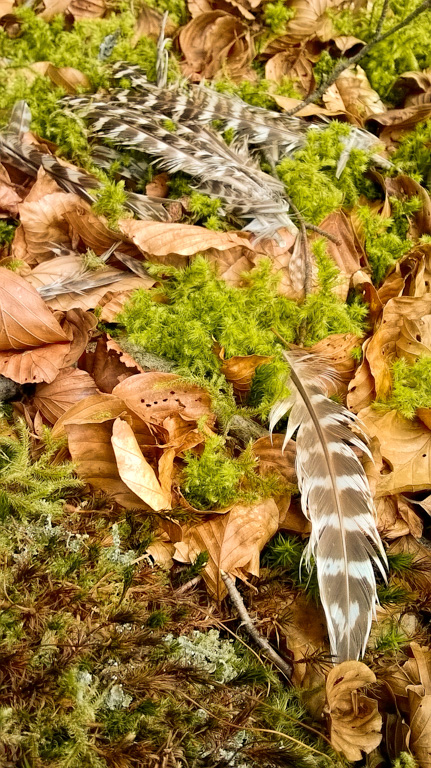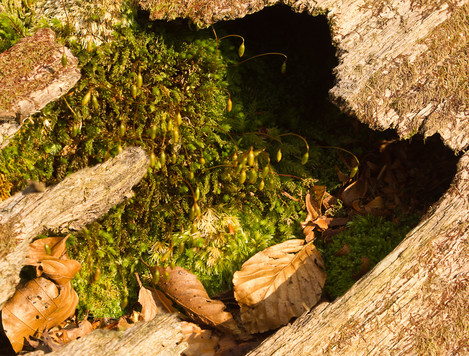Phil Hemsely talks about his feelings for Fernfire Wood

Phil Hemsley
Photography of the landscape and nature is a passion. I try in my photography to record the atmosphere and ambiance of my subjects - be that the upland landscape of Dartmoor, to photographing wildlife or adventure sports from an 'up close' aspect.
During the week I am a Mathematics Lecturer at Exeter College, and make detours on the way home if the light and weather look promising for some landscape or wildlife photography.
Upon turning a corner, as I wandered along the old green lane towards the edge of Fernfire Wood, two roe deer does scuttled along the high banks in hasty retreat, their white tufted hinds like beards of two dancing Santa’s disappeared quickly out of sight. A pair of dithering pheasants darted around, zig zagging in their amusing way, not quite as sure as the deer of where to go – portraying the staccato clucking noise of two car engines being started on nearly flat batteries. It had been some year and a half since I had last entered the steep slopes of the upper part of the Yealm valley, in autumn. It was early spring now, the graceful skeletal forms of the trees devoid of new greenery as yet. Here and there were splurges of yellow gorse, heralding the new season.

Fernfire Wood is a conduit into the Dendle’s Wood National Nature Reserve, also a Site of Special Scientific Interest, which also includes Hawn's Wood. It requires an access permit to wander these woods and I am very grateful to have had the chance to visit it over varying seasons and years. It is infrequently visited by conservation & wildlife trusts to monitor things, as a result, it is a place where one can experience solitude on a grand scale. The reserve is trisected by the River Yealm and its y-shaped confluence with the Broadall Lake (an unusually named brook).
One of the many falls and plunge pools along the young River Yealm, cascading over the plutonic moorland rocks There are other tributaries to these waters too. It's an example of ancient native beech and oak moorland woods with woodland pasture, rich in species of flora and fauna. It is home to the violet ground beetle, hiding under leaf litter or fallen wood until dark; to Dippers darting between the semi-submerged river boulders; a place of wood anemone bursting forth before the new oak leaves above; where wild sorrel decorates mossy banks & prone trunks, as butterflies glide by. It is one of a handful of places in the country to find the endangered barbastelle bat. By late spring the Pied Flycatchers will return from Africa to live in the boreal canopy of this valley with the uplifting song of Skylarks and stonechats adding to the chorus in the summer months.
To step through the gate to this 100-acre wood is to cross the threshold into some other land, some other bubble of deep time, not unlike the imagined realms of Middle Earth. It gives a connection to our past, a hint of the old Dartmoor Forest. Within the boundaries are the remains of ancient Bronze Age (3500 years old) stone-built hut circles in which prehistoric people lived can still be seen, and three medieval farmsteads but now, nature has reclaimed most of its ground. The approach to woodland management is largely to leave it to the inherent machinations of wild nature. In doing so the numerous beeches and oaks that have keeled over in the winds, have been micro-ecosystems harbouring epiphytic mosses such pillow and bank haircap, ferns and bracket fungi. Where holes have weathered into the fallen trunks, so the mosses have carpeted the voids. Where the timbers are left in-situ, they become a life support for simple plants and harmonious, in time, with the ambience of the woods.
In one of the delightful unnamed tributary gorges, the lower falls cascade over a tapestry of green velvet trunks and the carpeted ancient plutonic rocks - bedecked here and there with ferns, from mid-spring to autumn. Leaf litter of uncountable autumns makes a soft humus away from the main access track, at times filling the voids between the boulders calling for caution with steps, to avoid a twisted ankle.
Despite the gurgling, roaring and gliding tones of the moving waters there is a quietude too. Time spent in the midst of this, you find that your hearing has attuned; the river and the breeze become layers in this solitude and a state of mindfulness slowly ensued. The German’s have the uniquely beautiful word Waldeinsamkeit that means the feeling of being alone in the woods - a sense of wonder, poetic, meditative and in tune with the universe.
There are subtle variations in noise - such as deer slinking through bushes and brackens. Then here and there, tiny bright pin cushion moss - adrift in the furrow of a withered beech. Later on, the underbelly feathers of a common cuckoo which, despite its attempts of Batesian mimicry, seems to have had a skirmish with one of the hawks or buzzards that it tries to masquerade as (which it does in order to confuse the host nest owner where it wishes to lay its egg in a brood parasite manner). The natural world, it seems, is not without its ironic doses of karma.
It is always a pleasure to return and see the place - to experience its enchanting atmosphere. A veritable smörgåsbord of aromas; layers of concordant harmonies & intermittent sounds; cornucopia colour tones; to see the woodland wildlife and the odd startled sheep (that somehow look like they know they are not supposed to be in here!); to touch the forms & textures of withered wood, smoothed river granite; to taste the apple-peel tang of wild sorrel. For such reasons it is always for me a strange sense of fond farewell and with some regret to walk back out of the gate and along the track to the modern world.












